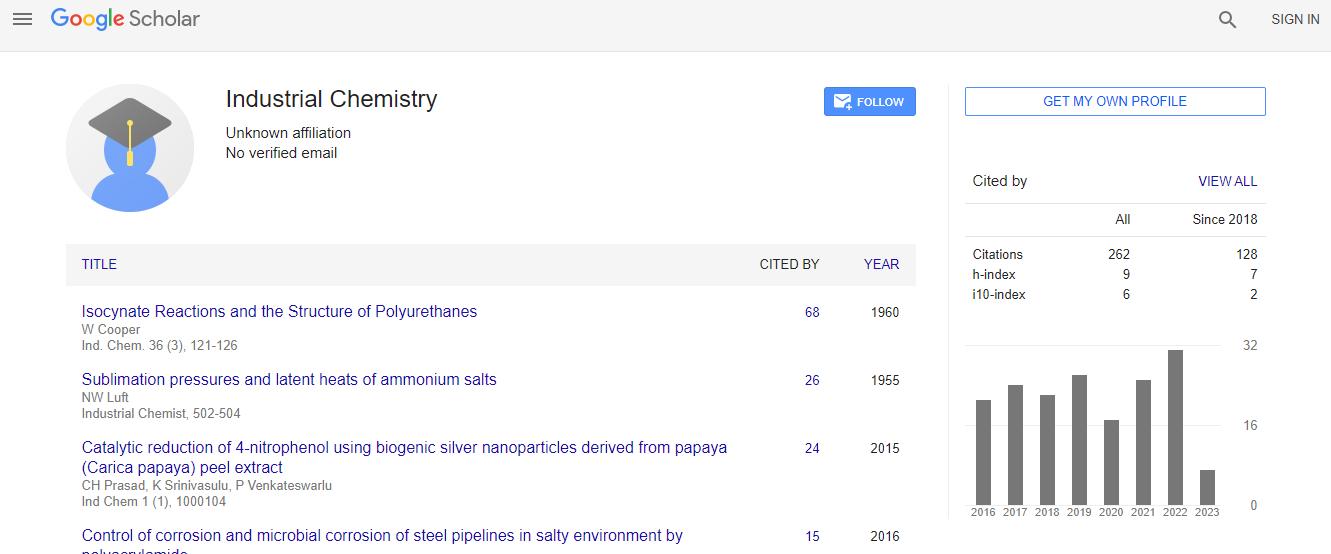Our Group organises 3000+ Global Conferenceseries Events every year across USA, Europe & Asia with support from 1000 more scientific Societies and Publishes 700+ Open Access Journals which contains over 50000 eminent personalities, reputed scientists as editorial board members.
Open Access Journals gaining more Readers and Citations
700 Journals and 15,000,000 Readers Each Journal is getting 25,000+ Readers
Google Scholar citation report
Citations : 262
Industrial Chemistry received 262 citations as per Google Scholar report
Indexed In
- Index Copernicus
- Google Scholar
- RefSeek
- Directory of Research Journal Indexing (DRJI)
- Hamdard University
- EBSCO A-Z
- OCLC- WorldCat
- Scholarsteer
- Geneva Foundation for Medical Education and Research
- Euro Pub
Useful Links
Recommended Journals
Related Subjects
Share This Page
Microalgae nitrogen recovery using hydrothermal carbonization
2nd World Conference on Industrial Chemistry and Water Treatment
Silvia Roman, Andres Alvarez-Murillo, Charles Coronella and Saeed V Qaramaleki
University of Extremadura, Spain University of Nevada, USA
Posters & Accepted Abstracts: Ind Chem
Abstract
During last years, increasing concern on climate change has motivated the scientific community to find ways for carbon dioxide sequestration. In this frame, synthetic algae growth offers significant advantages, such as simplicity, fast growing rates, and potential for biodiesel production. Recently, the possibility of converting algae to other valuable products has also been studied; hydrothermal carbonization (HTC) offers many advantages over other thermochemical processes, because of its low cost, favorable energy balance, and does not require an expensive drying step. Several works have showed the potential of HTC for increasing the heating value of biomass; however, very few studies have been devoted to study how experimental conditions affect N fixation on the hydrochar (HC), which can be highly desirable for some applications, such as adsorption or production of electrode materials. Moreover, the migration of N to the liquid phase (LP) might also be interesting allowing its further use for algae growing. In this work, Microalgae Scenedesmus was chosen for study because of its outstanding ability to grow in variable culture media. The HTC process was conducted under different conditions (temperature, time and biomass loading), hydrochars with variable N content were obtained, and the chemical equilibria involved in the process were investigated. HPLC analyses on the LP allowed identifying numerous N containing species. The fate of other nutrients (P, K, Na, Ca & Mg) was also investigated. It was found that while temperature had a clear effect on solid yield, its effect on the HC composition depended on the other variables. In general, for shorter HTC times (5 h), higher temperatures enhanced protein hydrolysis and thus the migration of N to the liquid phase in the form of amino acids which were further decomposed to O and N-containing species (carboxylic and organic acids, amines and ammonia). For larger time periods (20 h) temperature only played a secondary role and N fixation on the HC was significantly reduced in relation to 5 h experiments. Biomass loading did not show a significant effect on N distribution.Biography
Silvia Roman is an Associate Professor at the University of Extremadura, Spain. Her teaching includes subjects like technical thermodynamics and thermal engineering. Her research is focused on the use of wastes for energy via thermochemical processes as well as the production of porous materials for several applications. She has published more than 50 scientific papers on these topics and has patent on the production of activated carbon for radioiodine adsorption. During last years, she has been main researcher of several funded projects on the hydrothermal conversion of biomass. She has recently been awarded with research and teaching recognition prizes such as Excellence to Young Researcher Career and Teaching Excellence, by the University of Extremadura.
Email: sroman@unex.es

 Spanish
Spanish  Chinese
Chinese  Russian
Russian  German
German  French
French  Japanese
Japanese  Portuguese
Portuguese  Hindi
Hindi 